
drawing, print, ink, pen
drawing
ink drawing
pen illustration
pen sketch
figuration
ink
pen
genre-painting
modernism
Dimensions: image: 250 x 355 mm sheet: 326 x 411 mm
Copyright: National Gallery of Art: CC0 1.0
Editor: Here we have "Avant-Garde (The Patteran Society)", a 1950 drawing made with pen and ink by Cooper Nott Lansing. There is a sort of nervous energy about it. Everyone is so animated, gathered in this small room. How do you interpret this work? Curator: Well, instantly my mind leaps to thinking about 'Patteran'. It's a fascinating term. Originally, it signified markers – twigs, stones, signs – left by travellers, often Romani people, to guide others. So here, we see a society self-identifying as forward thinking leaving, maybe intentionally, clues in their presentation, what do they hold valuable, which artistic concepts are crucial to them? Editor: Clues, like what specifically? Curator: Look at the artworks depicted in the background. Almost crude symbols…a guitar, the human face, seemingly abstracted. Then the central figure gesturing before an abstract artwork…Consider also the body language – those observing versus the active speaker. Do you notice the way certain individuals hold themselves, the repeated symbols such as filled glasses? What could these physical characteristics be signaling to those in this society, to us? Editor: So you are saying that, like the Romani people, they were signaling their way of life? Their "avant-garde"? I had not considered how the work could suggest group belonging via its symbolic content! Curator: Exactly. And such subtle clues tell us so much. It speaks to their identity, their aspirations, and ultimately, their place in the world. What symbols are being shared here to indicate what values unite the group? It's like visual language, isn’t it? And a record that continues beyond the depicted time. Editor: I see, thanks for walking me through this, now I have an image of that period! I would say I appreciate how looking closely at seemingly small clues allows one to unpack greater historical insight.
Comments
No comments
Be the first to comment and join the conversation on the ultimate creative platform.













